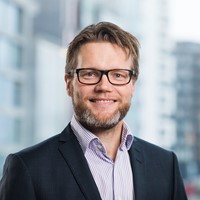Fiat currencies, central banks, commercial banks, and even governments themselves face a looming credit crisis.
Without a proper knowledge of the legal basis which defines gold as money and that everything else is credit, we cannot fully understand why the only escape for individuals from the growing financial calamity faced by America, Britain, Europe, and Japan is to sell credit to buy physical gold bullion and coin.
As to the danger, you would have to be a blind deaf mute to not be aware of the mounting instability in our credit system. Not only are central banks, issuers of our currencies technically bankrupt, but profligate governments with debt to GDPs of 100% and more are as well. Additionally, commercial banks face a range of crises which through systemic risk threatens to collapse the entire western banking system. And anyone who blithely thinks that these problems will go away with lower interest rates (as widely expected in heavily managed markets) displays irrational hope over rational thinking.
The reality of today’s credit markets is that in the not too distant future they face the prospect of a total collapse. The only escape for those seeking to protect their wealth is to get out of credit. This includes all financial assets. But to sell down risk exposure and to leave the proceeds on deposit at a bank still leaves investors with a pig-on-pork credit risk. There’s the bank itself and also the currency in which the deposit obligation is recorded. It is fiat, meaning that its value in terms of purchasing power is down to no more than faith — faith which is initially decided by foreigners in the foreign exchanges, likely to catch domestic users on the hop unexpectedly.
The only escape from this looming credit crisis is to possess physical gold — bullion and coin. But to understand why requires us to unwind decades of Keynesian and statist anti-gold propaganda. Accordingly, this article puts gold and credit in their proper legal contexts, so that the reader can truly understand why gold is the only escape route from a gathering credit crisis, and therefore act to protect his or her wealth with a confident understanding of the why and the how.
I strongly urge my Substack subscribers to read this article at least twice. It has never been more important to understand why in a general credit crisis, the only refuge from it is ownership of physical gold.
The current position
It is common to think of gold as a hedge of some sort, either against inflation or uncertainty. Ask the question why, and invariably the response lacks logic and credibility. After all, if Keynes was right to say that the gold standard was a barbarous relic, and the dollar is now regarded as the money to which all others refer and has been for at least the last 53 years, why is gold still a safe haven from anything?
This imponderable must be addressed, answered, and understood as the accumulation of unproductive debt in both public and private sectors threatens to overwhelm us. Investment managers and advisors who are paid by us to know about these things are almost completely clueless. I estimate that of the $150 trillion in global financial assets, only $208 billion is invested in physical gold ETFs. We can exclude personal ownership of coin and bullion because they are not regulated investments. That means portfolio exposure to regulated ETF gold is only 0.48% of the global total. That is the slam-dunk evidence of the ignorance of your financial advisers and managers.
Not that possession of an ETF entitlement is possession of the underlying asset, let alone when it is gold. A gold ETF is little more than a comfort blanket which Nanny can take away from you. Your certificateless entry on a register is an extra layer of credit as distinct from ownership, replacing certificates, which in turn were a claim on the ETF’s underlying assets only in liquidation. If gold is to be a hedge of credit risk, then it is the absence of counterparty (i.e. credit) risk that matters. But an ETF is the only way in which an investment professional can obtain exposure to the price of gold without confronting his compliance officer.
The fact is that gold has become a martyr to the consequences of ignorance by regulation.
One of life’s truisms is that markets always win out in the end. By that, it is meant that governments can distort markets by intervening, suppressing, and propagandising but eventually these attempts fail. And when that happens and portfolio exposure to gold and related investments return to only some sort of historical norm, then less than half of one per cent exposure to gold should be raised to somewhere between five and ten per cent of your investment portfolio. Of course, that will be made up of ETFs, bullion held directly, stored, and recorded as a financial asset, and mining shares. But at current dollar prices 5%—10% of that $150 trillion is the equivalent of between 114,000 and 228,000 tonnes of gold, the latter figure being significantly more than all the gold mined in history.
Clearly, a proper understanding of what gold represents, and whether it is still to be regarded as money is of the highest importance. As a systemic collapse begins to evolve, it will be reflected in a rapid rise in the gold price beyond anyone’s imagination.
There’s very little understanding behind the rise in gold
Today is a time of disinformation and bad analysis. And now with higher interest rates exposing the follies of irresponsible debt creation, there is a high level of nervousness abroad. Undoubtedly, there are huge risks in the financial system, in plain sight for all to see.
Equally, the vast majority of gold bulls can only resort to technical analysis, which is valid as a trading tool but does not explain what is actually driving the relationship between gold and fiat currencies. Unlike other markets, there is an additional difficulty with gold because those that accumulate bullion don’t shout about it and generally don’t want the world to know. It is therefore a market ripe for conspiracy theories instead of rational analysis.
Much of the confusion arises from the traders’ premise that interest rates are the cost of money, by which they mean currency, while the lease rates for bullion are very low and relatively static. Therefore, they claim, rising interest rates are bad for gold. It should be noted that the establishment represented by bullion banks is nearly always on the short side through derivatives and unallocated gold deposit accounts, so they have a vested interest in pushing this line in defiance of the facts. It is an establishment’s concept which kow-tows to gold no longer being regarded as money.
In the past I have drawn attention to the experience of the 1970s, which started with gold valued at $35 to the ounce and the Fed Funds Rate standing at about 6%. At the end of the decade, these two measures were $850 and 19.5% respectively. But we have a current example. In September 2022 gold was valued at $1680 and the Fed Funds Rate was 2.5%. Despite nearly everyone telling us that interest rates and gold cannot rise at the same time, today we see gold valued at over $2,000 and the Fed Funds Rate having more than doubled.
Then there is the belief that gold is no longer money because no one uses it to buy and sell things. Therefore, they say, the dollar is money. I even find economists who favour free markets taking this line, dismissing Gresham’s Law, which explained why only clipped coins circulated. To be consistent, these economists would have to have deemed unclipped coins as no longer money, because they did not circulate.
Economists dismissing the difference between money without counterparty risk and credit with counterparty risk is a fallacy borne out of Keynes’s description of the gold standard as a barbarous relic, and more importantly fifty-two years of intense anti-gold propaganda led by the US Treasury after President Nixon suspended the Bretton Woods Agreement. Huge damage has been done to our understanding of these matters, not that they were well understood in the first place. Therefore, our starting point has to be to correct these misconceptions before we can even talk about why the value of gold expressed in fiat currencies is rising.
Defining gold as money
Before discussing the difference between gold and credit, we must clarify the relevant definitions. Strictly speaking, all forms of mediums of exchange are credit in the sense that under the laws of division of labour, we produce goods and services first in order to consume. If you sell your labour for gold coin, it represents the temporary credit of unspent labour. Where this differs from a medium of exchange which is a promise to pay is that a promise to pay incorporates an additional form of credit — credit which bears a risk that its value might not be honoured. This category includes both commercial bank counterparty risks in the form of cheques drawn upon a bank and electronic transfers. It also includes an unbacked currency issued by a central bank in the form of notes and token coin, as well as its promise to honour all its balance sheet liabilities.
In the middle stands gold substitutes. A gold substitute is a currency issuer’s liability in the form of its bank notes and liabilities to its depositors which is fully convertible into a fixed weight of gold on demand. As mediums of exchange they don’t exist anymore, given that no currencies are convertible into gold today. Therefore, for clarification we have three definitions for media of exchange: the highest form of credit which has no counterparty risk is gold, which we can define as true money. There are then two forms of credit: gold substitutes, so long as they are honoured by the issuer by readily exchanging its liabilities for gold coin and bullion, and credit which is not convertible into gold on demand, whether issued by a central or commercial bank. This article will use these conventions to distinguish between money which is only physical gold, and credit.
In previous articles I have recorded the history of gold as money in Roman Law. The origin of Roman Law was the Twelve Tables (or tablets), ratified in 449 BC and venerated by Romans as their primary legal source. They were superseded by later changes in Roman law, but never abolished. And according to Gaius, of whom more follows, it was at this time that the first Roman coin, the aes made of bronze, was introduced. In its early form it was more a standardised weight of bronze-like metal than a coin as we know it today, said to weigh a little under one third of a kilo.
Credit certainly existed before then, though not on a formal basis. Trade has always required credit, because time elapses between the acquisition of materials and their delivery to market in either raw or processed form. The Phoenicians were trading throughout the Mediterranean a thousand years before Rome’s Twelve Tables and in addition to bartering would certainly have required credit to do so, because they had no coinage before Roman times. Clearly, the need to fix the value of credit led to demand for its expression in a superior form of credit without counterparty risk — hence the emergence of real, tangible money.
The Twelve Tables was also at a time of intellectual development, being contemporary with the great Greek philosophers — Socrates, Plato, and Aristotle among others. Coincidentally, Confucius was advancing Chinese philosophy only fifty years before. There is reason to believe that the flowering of philosophy is stimulated by improved economic conditions, always associated with developments in money and credit.[i]
Roman law took its next evolutionary step when Gaius wrote his Institutiones as well as a commentary on the Twelve Tables in about 161 AD. It provided a template for Justinian’s Institutes (or Pandects) with some of Gaius’s passages even copied verbatim. Gaius’s original manuscript was lost until it was rediscovered as a palimpsest in Verona in 1816 by a German scholar.
With respect to credit and banking, fifty years later the judgements of Ulpian and Paulus superseded and improved on Gaius’s by ruling that credit could be transferred for value without the agreement of both originating parties. This meant that debt could be freely sold on for value without the consent or knowledge of the debtor. It was probably on Ulpian’s advice that the emperor Alexander Severus in 224 AD published his Constitution formalising this freedom.
This vital step meant that credit could be incorporated as personal wealth, which we can define simply as comprised of anything which can be valued in a medium of exchange. By the time of Justinian’s Pandects in 553 AD, the legal principal of the transferability of credit was well established and incorporated in them, and also confirmed in the Basilica of the Eastern Empire which followed 339 years later.
Between the Pandects and the Basilica, the principal that tangible money was the highest form of credit from which lesser forms took their value became firmly established in the two Roman Empires and in their successor nations throughout Europe. The great waves of discovery and colonisation by these nations in more recent centuries spread not only their Christianity, but with respect to money and credit their laws founded on Roman origins.
For a time, English common law was in a confused position, common law having inherited its precedents from Gaius, which were current when the Romans left Britain in 410 AD, and before Justinian’s Pandects over a century later. Severus’s Constitution appears to have not been fully adopted.
However, with respect to the transferability of credit and therefore the inclusion of debt obligations as personal wealth in the UK, the situation was regularised when conflicts between common law and the Court of Chancery, which dealt with matters of equity, were abolished in 1875 after enabling legislation was passed in 1873. And in pre-constitution US law, Blackstone’s Commentaries on English common law was the standard legal treatise in American law (as opposed to Chancery), adopting Roman law thereby.
The entire world outside Asia had and still has at its basis gold as legal money. The great Asian civilisations had their own interpretations, which have the same conclusion. Furthermore, for millennia people independently agreed that being durable, divisible, and identifiable money is metallic, and gold, silver, and copper became preferred. Roman law was an expression of this reality. Whatever regulations may say, and whether governments confiscate or try to persuade their citizens otherwise, the legal position remains.
The definition and role of credit
While the argument that gold is no longer money violates the human and legal facts, credit is confused with money, because it is routinely described as money. Nowadays, what governments and economists describe as money supply is entirely made up of credit. The best way to understand the difference is that credit is an agreement between two parties with a matching obligation in the form of a debt. It is classified as an incorporeal asset, having no material existence. Money is not a credit agreement, being corporeal having a physical form.
The Roman juror Ulpian led the way in defining the difference. A depositum is a person’s property entrusted to the care of another. Thus, a sealed bag of gold coins, given to the custody of a banker, remains the property of the depositor, and the property in it is not transferred to the banker. A modern example is a custodial relationship, whereby a bank or similar institution stores bars of gold on behalf of others, not using the asset for its own purposes, and not including it in its own balance sheet.
But if a person gives gold coins to a banker on the basis that the banker will return the same value in coins on demand or at a future date, that is a mutuum, where the property in the coins deposited is transferred to the banker for him to use as he sees fit. The value of those coins will be included in the banker’s own balance sheet as an asset with a matching liability to the depositor. That is credit, and Ulpian’s definition is the basis of all banking and economic activity today.
To summarise, credit is the transfer of property from one person to another where the latter has a matching obligation, or debt, to return the property to the former. Credit is the entire basis of banking today, which was invented by the Romans. They were the first to use cheques and bills of exchange, but these forms of credit did not circulate as mediums of exchange, restricted to obligations between immediate parties. This was the basis of Gaius’s Institutiones, ruling that a credit agreement could only be transferred to another party with the agreement of both creditor and debtor.
Ulpian contradicted Gaius later, ruling that credit was incorporeal wealth. Translated from the Latin, he said, “Under the term Wealth, not only ready Money, but all things both movable and immovable both being corporeal things and Rights are included”.[ii] The point to understand is that wealth is property, both corporeal and incorporeal, whose value can be measured. The value of incorporeal property can only be measured if it can be transferred freely. Gaius’s earlier ruling was an impediment to valuing credit and its matching debt obligation because it required the endorsement of the original parties.
With respect to credit and banking, fifty years later the rulings of Ulpian and Paulus superseded and improved on Gaius’s by ruling that credit could be transferred for value without the agreement of the originating parties. This meant that debt could be freely sold without the consent or knowledge of the debtor. It was probably on Ulpian’s advice that the emperor Alexander Severus in 224 AD published his Constitution formalising this freedom.
This vital step meant that credit could be incorporated as personal wealth. By the time of Justinian’s Pandects in 553 AD, the legal principal of the transferability of credit was well established and incorporated in them, and also confirmed in the Basilica of the Eastern Empire which followed 339 years later.
Between the Pandects and the Basilica, the principal that money was possession of physical gold, silver, and copper from which credit took its cue became firmly established in the two Roman Empires and in their successor nations throughout Europe. The great waves of discovery and colonisation by these nations in more recent centuries spread not only their Christianity, but their laws with respect to money and credit founded on Roman origins.
The relevance to today’s currencies
The distinction between legal money and credit, particularly in the form of unanchored currencies, is barely understood today except by very few. As pointed out in the introduction to this article, only a small minority believe in gold and even that is on the basis of a vague argument that it has survived as money through the millennia, without knowing the legal basis. But it is the legal basis which matters at least as much, if not more, than gold’s historical role in the division of labour.
This is why only statist propaganda, that currencies are money and gold is no longer money, can contradict the legal position. This is also why despite all US Government denials the dollar still retains the link to gold at $42.22 to the ounce. But so effective has been the propaganda that very few people understand the implications of mistaking credit with counterparty risk for money without counterparty risk: the incorporeal is not the corporeal.
Without the discipline which turns a currency into a credible gold substitute, the value of a currency depends entirely upon the faith in it as a medium of exchange. And without that discipline, issuing governments feel freed from the constraints of gold. They then expand credit obligations seemingly without limitation. The eventual conclusion is always the same: freed from the fiscal requirement to act responsibly, the state’s profligacy always ends up destroying the currency.
The message for those yet to accumulate any physical gold is that you should read this article at least twice to fully comprehend the legal distinctions between gold as money, and credit. In the increasing likelihood of a credit crisis encompassing currencies, bank deposits, and all financial assets, owning and possessing real money without counterparty risk will be the only value left standing.
[i] An example was the Scottish enlightenment, which followed the introduction of cash credits by the Royal Bank of Scotland in the 1720s. It created a commercial revolution which generated wealth, followed by the flowering of Burns, Hume, and Smith.
[ii] See HD Macleod’s The Theory of Credit, Chapter 1, 11.










